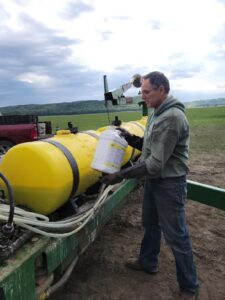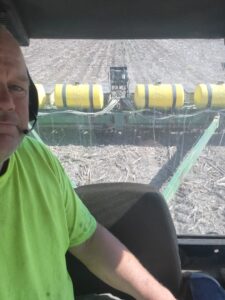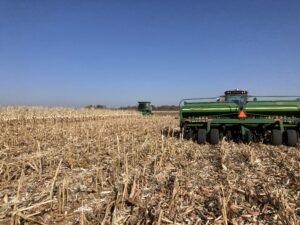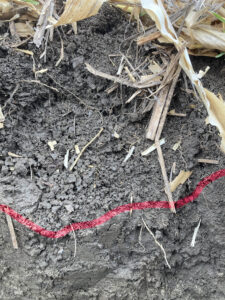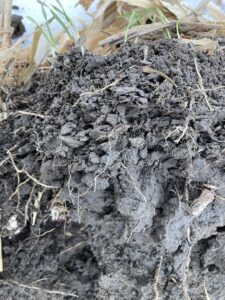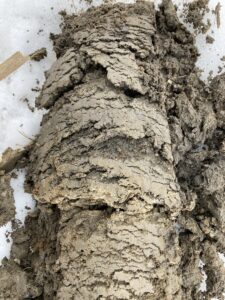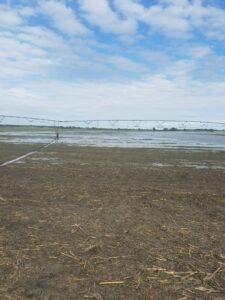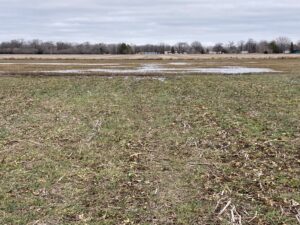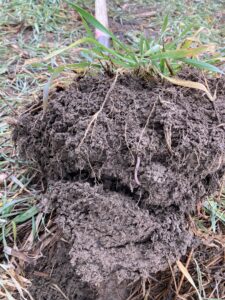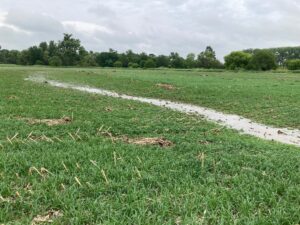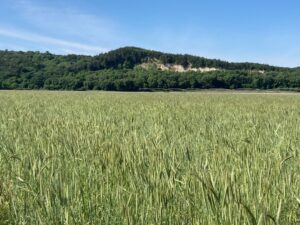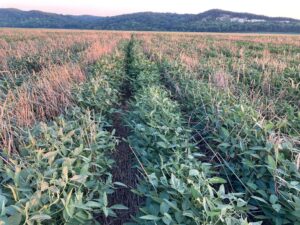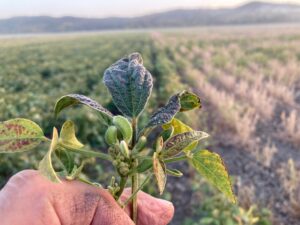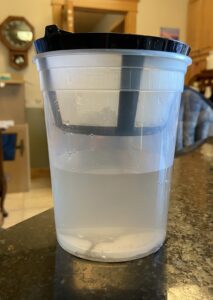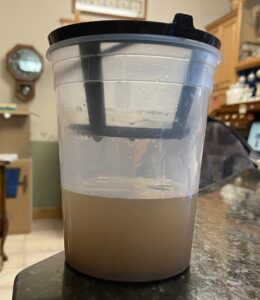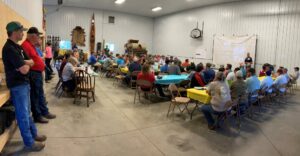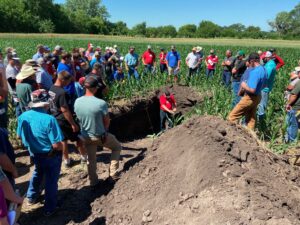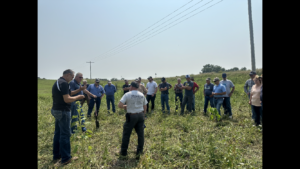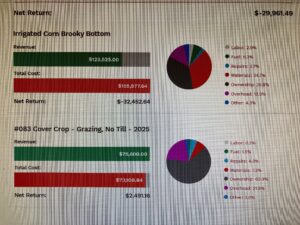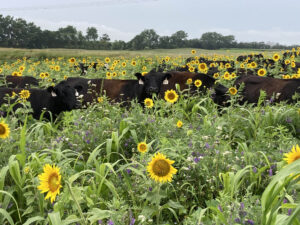Progress report for FNC22-1354
Project Information
This project is located on Matt Weinandt's farm, who is partner in this project. Matt and his son Dustin farm around 600 acres. Cropping consists of Corn, Soybeans and Alfalfa with occasional small grains. They also run a small Cow Calf herd.
Jeff Steffen, The coordinator of this project has a similar size farm. He has been No-Till for 30 years and the last 10 years has been going to a more diversified rotation with cover cropping. He is hoping to transfer the improvements in soil health that he has seen on his farm to Matt's farm and possibly accelerate the change with biologicals.
His crops consist of Corn, Soybeans,Oats,Cereal Rye, Peas and Buckwheat.
One barrier to overcoming adoption of soil health management systems (SHMS) is the amount of time (5-7 years in some cases) it takes to see improvements to soil and farm profit. In this case we have a poorly producing, degraded alluvial soil in the Missouri river bottom of northeast Nebraska. Historically the answer has been more and deeper tillage in the mostly corn and soybean rotation. This has degraded soils even more to the point that even irrigated yields are poor in relation to the high inputs used. Low profitability contributes to high farmer stress and less opportunity to bring the next generation into the operation.
We will evaluate the increase in environmental, economic and social benefits of four different management systems: the status quo, a SHMS with a more diverse rotation and the use of cover crops and livestock, and SHMS with the addition of biological amendments from Advancing Eco Agriculture and Elevate Ag.
We will evaluate soil health, profit, and social responses to system management to see if they can be attained quicker from the addition of biological amendments. Quick initial improvement would provide greater incentive to adopt and continue the SHMS for long term gains.
1-Evaluate biological amendments ability to accelerate soil health.
2-Evaluate the economic profitability of soil health management systems (SHMS) with and without biological amendments.
3-Assess the stress level and job satisfaction of farmers implementing SHMS.
4-Assess the likelihood of biological amendments increasing the adoption of SHMS and their ability to bring the next generation into the farming operation.
5-Create and share a fact sheet at in-person events, post to the Bow Creek website, and display at the local Fair.
6-Educate 80-120 producers, 5 crop consultants/agronomists, three ag lenders, and three media contacts about the project and findings.
Cooperators
- - Technical Advisor (Educator)
- (Educator)
Research
In order to assess the efficacy of Biological amendments on increasing soil health in tight clay soils we mapped out a 48 acre rectangle on an irrigated quarter on flat bottom land along the Missouri river. We planned to separate the 48 acres into 4 , 12 acre plots with different treatments.
They were:
1. Control; current farming practice on the field. (Corn, Soybeans, no cover crops, no till with occasional tillage)
2. Soil Health Practices; Year 1, Cereal Rye cover crop terminated and planted to Corn. Year 2, Cereal Rye taken to harvest followed by muti species cover crop that will be fall grazed.
3. Soil Health Practices of #2 plus Elevate Ag's Biological amendment program.
4. Soil Health Practices of #2 plus Advancing Eco Ag's amendment program.
At the suggestion of Mitiku Mamo we put in replication strips to account for variability.
We are hoping to show that by following Soil Health principals we can improve the tight clay soils. Having something growing at all times and the introduction of a robust multi species cover crop mix will hopefully work its way into the lower soil profile which is currently not being used by the cash crops.
The fall/winter grazing of the multi species cover crop will provide income for Matt and Dustin's cattle operation and we plan to only graze half to leave a matte of healthy biomass on the soil surface.
The Biological amendments will be added on 2 plots to analyze if this speeds up the soil health process.
All plots will be analyzed for soil health and profitability.
Yields were weighed with a grain cart scale at harvest. There was only subtle differences in yield which I (Jeff Steffen) expected as from experience it takes more than one year to start to see differences. Luckily we had replications in the plots as yields increased in general as we went from east to west. This probably results from a slight elevation change from east to west as Matt said with the poor infiltration rates water would migrate from the west and pond on the surface to the east. This resulted in historically poorer soil conditions on the east side. Yields were adjusted to an average of the replications,hopefully giving us better data.
Adding product to planter Planting test plot Weighing plot and seeding next years cash crop
| Plot Treatment |
2022 Corn Yield Net Return Above Economic Cost @ 6.80 Corn |
| 1. Control (west end) current farming practices (Starter fertilizer) | 171.8 $171 |
| 2. Cereal Rye cover terminated 10 days prior to planting Corn (No Starter) | 164.2 $153 |
| 3. Same as #2. but with Elevate Ag Biological program | 166.7 $143 |
| 4. Same as #2 but with Advancing Eco Ag amendments program |
163. $116 |
Yields were fairly equal but still generally lower than what is expected from irrigated corn in northeast Nebraska. The control and its replication were toward the west of the plot where yields were generally higher. There was also probably a response to the starter fertilizer. The Elevate Ag program#3 showed slightly more yield than #2 and #4.
A 4 foot soil pit was dug in December to analyze any change in the cover crop treated plots.
Restrictive layer for roots Next years crop already putting Tight restrictive layers in the deeper
roots down subsoil.
The soils are showing more aggregation in the top foot of the profile but below 2' root growth was non existent. Infiltration rates tested in the spring were very low (.03 Sorptivity or initial infiltration). It is hoped that allowing the Cereal Rye go to maturity and then planting a multispecies cover will be able to penetrate into this tight lower profile.
(Year Two Update)
Due to flooding issues on the bottom land soils, we could not finish the project as we had hoped. Parts of the test plot were under water so the Summer Small Grain harvest was severely delayed. This delayed the cover crop mix seeding. We had good stands but I felt with the late planting, we could not get enough growth to help deal with the deep compaction of the bottom land soils.
We have received an extension on this project so that we can move it into a third year. The project would be completed in December with a final report done at that time. Currently there is a growing cover crop on the test plot so we are hoping for better luck this year.
Spring 2023 East side of test plot February 2024 There was infiltration February 2024 showing surface
under water improvement. Background is an Alfalfa field aggregation
( Year 3 Update)
It was another tough year in Brooky Bottom with record rainfall in May followed by record dry in August, September. The spring started well with the plots showing the best cover crop growth to date. Heavy rains in May were somewhat mediated by the good cover crop growth but it was still June before we could get Soybeans planted in the plots.
Heavy rains in May Finally dry for planting in June 4000 lbs. biomass/acre
Although the Soybeans were in late, establishment was good. Then at the time of first application of biologicals it was noticed the Non-GMO Soybeans were showing evidence of Dicamba drift. We continued with the test but the Soybeans ended up with significant damage.
Late August Soybean test plot Severe Growth Regulator damage
Yield of the test plots were quite low (in the low 20's). There was no statistical difference between the plots considering that the damage to the Soybeans was the limiting factor. Unfortunately this kept any amendments from making a difference.
There was however improvements observed in Soil structure where their was cover crop. Sorbtivity that was .03 in the spring of 2022 improved to .16 in the fall of 2024. Rainfall simulation showed good improvement in the cover cropped parts of the plot.
rainfall simulation from cover cropped plots rainfall simulation from non cover cropped plot
Soil tests from the plots that had biologicals applied showed a good diversity of microbes, however at very low levels. Probably not enough to make a difference. Chemical tests of the soil in all of the plots showed adequate N, P and K. Even SAP analysis of the crop in season showed mostly adequate level of nutrients. It was noted however that salt levels in the soil were very high. (Probably a result of very tight sub soils causing excess surface evaporation).
As far as our goals of the project.
1. Evaluating Soil Health increases from biological amendments. Physical observation methods of Soil Health showed differences between the plots with cover crops and the plot with none. The microbe analysis of the Elevate Ag plot showed good microbe diversity, however at very low levels. I feel we did not generate sufficient data to come to any conclusions on Soil Health increases from amendments. Going forward we plan to continue cover crops and possibly implement perennials as we continue to assess biological amendments.
2.Evaluating the profitability of biological amendments. I feel it was not met as a result of severe weather events and unfortunate herbicide drifts.
3. Assessing job satisfaction of farmers implementing Soil Health Systems . Interesting to note that Matt and Dustin, after witnessing farmer success at Bow Creek field days and seeing subtle changes in their own soil structure , now feel they have a road map to improving soil function on their farm and are coming up with their own plans to do so.
4. Assessing if biological amendments increase adoption of Soil Health Systems. We could not prove this due to events. However, Matt and Dustin are convinced that adopting Soil Health practices are key to bringing the next generation into the farming operation.
5. and 6. Educating and sharing facts. What we did learn we will be sharing at the Nebraska Ag Society conference In January. We will also be discussing this at local networking meetings we will be having in Jeff's shop.
Educational & Outreach Activities
Participation Summary:
The SARE grant project to improve soils in the Missouri river bottom is a part of a larger project to improve the whole Bow Creek watershed in which the creek itself is subjected to excessive nutrient loading. (Bow Creek Watershed Project, BCWP). Our team member, Becky Ravenkamp, put together a great field day at Jeff Steffen's farm to educate on soil health and show field demonstrations.
Part of the day involved a soil pit dug on Jeff's farm where Paul Jasa, Agriculture Engineer from the University of Nebraska explained what we should be seeing for structure and root growth in our bottom land soils. It was a good demonstration to show the 75 or so farmers how long term soil health practices on Jeff's farm had made for good soil function. It was also good chance to mention how we were working on a SARE grant project in Brookie bottom to improve that soil function also.
Jeff Steffen presenting soil health findings Paul Jasa analyzing and explaining soil function
Going forward we hope to show these improvements with a demonstration in Brookie bottom also.
(Year 3)
With the flooding problems in Brooky Bottom we decided to have another field day at the Jeff Steffen farm also sponsored by the Bow Creek Watershed Project. We are trying to study if we can fix problem soils like in Brooky Bottom with alternative cropping like annual grazing.
A group of farmers at the 2024 field day on Jeff Steffen farm observing soil improvement resulting from grazing diverse annual crops
Learning Outcomes
We have identified some improvement with better surface soil structure but we need to see this go into the lower profile and also we need to prove that we can generate more profits. The third year of the project showed continued increase of the depth of aggregation. However flooding events cause setbacks. I think added biologicals will only work if there plants there to feed them. One thing of note on the soil health tests was the soils lack of active Carbon. We will need to look at finding a diverse combination of high biomass cover crops and cash crops that can increase Carbon and eventually penetrate into the tight clay sub soils and bring the biology with them. (Possibly even a perennial system) We will continue to experiment with adding biologicals to this.
As is often the case Net Profits can sometimes be lower when producers first start the soil health journey. It takes a commitment of the producer that he wants to make it work. Increased profits from reduced inputs and better yields usually takes a few years.
Could we fundamentally change the cropping system? We analyzed a budget for Corn this coming year for 135 acres in Brooky Bottom and also included a possible budget for grazing annual forages instead of Corn. This is what we came up with.
Comparing budgets for possible crops in Brooky Bottom
Some of the major lessons learned,
We need more Carbon in the system.
Living diversity of plants may be more important than adding biologicals
The disadvantage for this project is that it is only a two year grant. We will continue working for improvement after our two years is up. The SARE grant was a great way for us to get started.
Project Outcomes
Here's a text I received the June field day from a young farmer who lives about 30 miles away.
"Just want to say your field day was the best one I've ever been to! I would definitely consider that a highlight of your agriculture career!"
I responded " Wow, thanks for the compliment. I know you get it. I hope a few others did also."
He responded. "Oh I'm sure plenty of people got it. And I gaurantee the hamster is turning for the others as well! Ha Ha!"
Another success of this project is how it has led a few farmers to think about fundamentally changing their cropping practices in these problem soils. If we want full year diverse growing plants that always have the soil covered and are just as or more profitable than Corn and Beans, how about this example?
Cows grazing a 13 way mix on the Jeff and Jolene Steffen Farm
